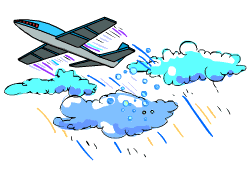induce rain from a cloud on a perfectly sunny day. Seems confusing, right? So let's talk about it.
Clouds are not, contrarily to popular belief, massive balls of cotton. 99% of a cloud is air, and this air contains moisture, which is present due to the evaporation of water by the heat of the sun. When
the evaporated water rises into the atmosphere, it cools (due to temperature change) forming water droplets that make up the clouds. In order for a cloud to produce rain, the cloud temperatures must be below water's freezing point. The droplets of the cooled water form ice crystals with any foreign materials (dust, salt, sand--heterogeneous nucleation, if you recall!) and soon enough are heavy enough to fall to the earth as rain.
As we all know, many locations do not get adequate rainfall, resulting in droughts. Scientists, after studying cloud formations for years, realized that the clouds that are not producing enough rain probably lack ice nuclei (dust, salt, sand, etc.) They hypothesized that if we were to add an ice-forming nucleating agent to these clouds, they would be capable of producing rain.
The Experiment
To test out their idea, scientists sprayed silver iodide (AgI, it is a chrystalline solid otherwise known as Dry Ice), which has a chrystalline structure much like that of ice, which increases ice crystal concentration, into a cloud. The chemical forced the freezing of present water droplets, and rain began falling from the cloud. The silver iodide acts as an ice nuclei, or embryo, for the droplets to form around.(see heterogeneous nucleation)
The "Recipe"
Usually, cloud seeding is done when an airplane flies over a particular cloud formation, releasing packets of tiny silver iodide particles. As soon as the silver iodide particles meet the cool moisture in the clouds, the formation of ice crystals is forced and rain, or snow in colder climates, results. Because too much silver iodide would be a pollution risk, very small amounts of the chemical is used. Another method that has been practiced is that of using smoke machines from the ground, and blowing silver iodide particles into the atmosphere.
In short, if you've got a spare airplane, a large cloud, and some silver iodide, then you yourself can make rain. And maybe practice will even be cancelled, too. Or, if you're in a climate cold enough, you've got yourself a snow day!!!

http://www.tip.csiro.au/History/images/
RainPlane.jpg

CLICK TO ENLARGE
http://www.water.utah.gov/waterplan/uwrpff/
Fig-14.gif
